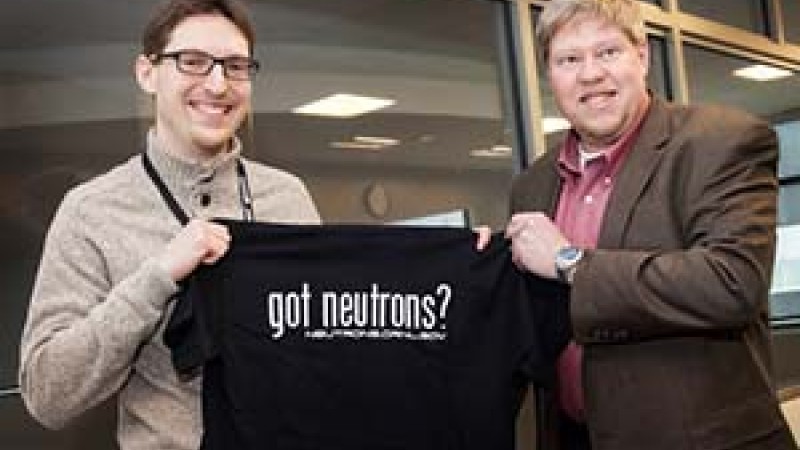The 10,000th neutron scattering user unknowingly passed through the door of the Spallation Neutron Source (SNS) this week, and the young scientist, who hails from France, got a warm welcome and some goodies from Associate Laboratory Director for Neutron Sciences Kelly Beierschmitt.
"It's your first time here? It looks like you won the lottery," Beierschmitt quipped as he shook the hand of Edwin Kermarrec, who officially becomes the 10,000 user of the Neutron Sciences Directorate’s High Flux Isotope Reactor and Spallation Neutron Source.
Kermarrec is part of a research group led by condensed matter physicist Bruce Gaulin from McMaster University in Hamilton, Ontario, Canada. The group—which includes Kate Ross of the National Institute of Standards and Technology (NIST) and Johns Hopkins University, Jerod Wagman of McMaster, and Gaulin—are working with ORNL instrument scientist Georg Ehlers at the Cold Neutron Chopper Spectrometer (CNCS), where they are studying geometrically frustrated magnets at low temperatures.
“The SNS is all about you; that is why we exist,” said Beierschmitt as he handed Kermarrec a black SNS ‘Got Neutrons?’ t-shirt. “Being able to recognize our 10,000th user here is something that we are very proud of.”
“We are creating living history here of the people who come to our facility. Twenty-five years from now, when you perhaps win the Nobel Prize, you will be history. We can pull out this photo, and your family and friends will say, ‘Look at him, how young he was!’ ”
Kermarrec, who completed his doctorate at the Université Paris-Sud, also received a travel kit and SNS tie pins, pens, and mouse pads to share with his group.
Gaulin’s McMaster group is studying a new frustrated magnet, the XY pyrochlore magnet Yb2Ti2O7. This type of magnet is called a quantum spin ice material and is currently of great interest because it displays an exotic disordered phase at very low temperatures in zero field and can be polarized by application of a relatively modest magnetic field. The physics of the system falls into that described by both geometrical frustration and quantum phase transitions.
“We will aim to characterize the spin excitations fully in order to extract microscopic exchange parameters for this exotic system,” Gaulin said. “Such characteristics are very well suited to study with CNCS.”
The group got their first results earlier at the Disc Chopper Spectrometer at NIST and now expect to improve significantly on the earlier results. “We’re expecting exciting results from CNCS by virtue of our experience with this material and preexisting data,” said Gaulin. “No doubt there will be surprises, but for this experiment, we know the lay of the land and we have a sense of where CNCS’s very impressive strengths can really be brought to bear on understanding this fascinating material.”
CNCS is designed to provide flexibility in the choice of energy resolution and to perform best at low incident energies. The instrument addresses a broad variety of scientific problems, ranging from complex and quantum fluids to magnetism and chemical spectroscopy.






